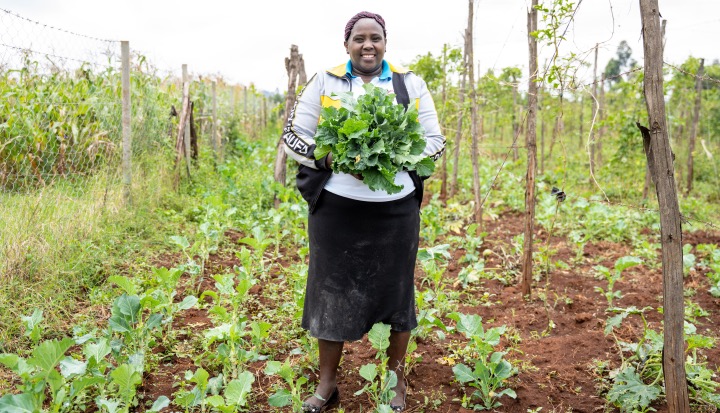Growing a Movement for Change
For smallholder farmers struggling with soils degraded by chemical fertilizers, pesticides and intensive farming, regenerative agriculture offers a solution that can improve soil health, increase resilience to climate change and fight rural poverty.
In partnership with the IKEA Foundation, Hand In Hand has worked with nearly 2,000 Kenyan smallholders to transition their farms to regenerative agriculture. A three-year project increased revenues by 155% – shows that there is no need to compromise between transitioning to regenerative principles and making agriculture a profitable option for farmers.
Here, Pablo TittonellUN FAO advisor and global agroecology expert, Nicholas Ciano permaculture specialist and founder of the Drylands Natural Resources Center and Japhet MuliHand in hand East Africa’s Regenerative Agriculture Leader, explain what needs to happen for rural communities to adopt regenerative agriculture.
Five key suggestions from our experts:
1. We need to calculate the value of the ‘business’
Frontline farmers must contend with land degradation, soil erosion, and the rapid decline of pollinators. Regenerative agriculture techniques promote biodiversity and help mitigate climate change by sequestering carbon in the soil. In fact, after the oceans, land is our largest “carbon sink.” However, if we continue with the status quo, smallholder farmers who produce a third of the world’s food will continue to see reduced productivity and increased food insecurity.
Dr. Pablo Tittonell explains:
“25% of the world’s agricultural land… They are no longer productive. And this is the main challenge for us to think about – feeding the world, food security and sovereignty… they need to be restored. They need to be restored.”
Japhet Muli agrees: “If we don’t come together and fund and support regenerative agriculture, what will happen to us, what will happen to society? Because we know that if we cannot protect the environment and the ecosystem, we will not be able to develop in laboratory technology – we cannot only eat lab-grown meat.”
2. Donors can help farmers by giving more time and being “co-innovators”.
When restorative practices are applied to land that has been intensively farmed for decades, it can take up to five years for the soil to regain full health. But, as Japheth Muli explains, most programs aimed at small entrepreneurs in Africa are only one to two years long, dictated by foreign donor funding cycles. To see the results of regenerative projects, Japheth argues, donors need to look at the longer term.
“If we look at the damage we have done to the environment, it will take a lot of effort and time to reverse it.”
Pablo Tittonell agrees and notes that the process of agroecology is a continuous dialogue with the soil itself, a basis for innovation and knowledge exchange. This contrasts with traditional project design, where the donor expects to see a fixed theory of change from the outset. “The donor may ask how many meters of irrigation pipes will you buy in your project? I would say I don’t know, because together with the farmers we have to decide whether we need irrigation… We need a process of innovation together with practitioners and donors.”
3. Women must be part of the changes
Women often lack the skills, resources and decision-making power to change farming practices. As part of its agroecological work, Hand In Hand disseminates gender equality training for men and communities to challenge norms and attitudes that leave women behind. Japheth Muli says:
“Especially in Africa, women do not own land and therefore do not have decision-making power. But most of the small farmers are women and they have a hard time deciding what kind of agriculture they want to do.”
4. We need to close the “regenerative research gap”.
Pablo Tittonell believes that a significant gap in the amount of research on organic and regenerative agriculture is holding the sector back. He says:Studies show that conventional farming (with pesticides, chemical feeds and fertilizers) is only 20% more productive than organic farming. However, 95% of agricultural research covers only traditional farming techniques. And that’s just government-funded research, not the private sector. If we can close this huge research gap and invest in alternative forms of agriculture, imagine how productive regenerative agriculture could be?
5. Regenerative agriculture should put money in farmers’ pockets
We know that the transition to regenerative agriculture will not be sustainable if it is not a financially viable option for farmers living at or below the poverty line. In Hand In Hand’s most recent project, which reached 1,948 smallholders (80% women), farm incomes increased by 155% – both through increased productivity and by reducing or eliminating the need for farmers to purchase expensive commercial farm inputs.
And this increase in income has occurred even in remote rural areas where premium markets for organic produce have not yet been established. But Nicholas Cyano believes that will change. “By 2050, 60% of the population (Kenya) will be in cities. They will need organic foods and that’s where the business is. Farmers can look at switching to regenerative practices as a business model with the potential to bring in a lot of money.
For now, he says, farmers can look to economies of scale rather than scale. “Because where you’re diversifying a lot of things and making your income a little bit here and a little bit there — it’s a sustainable business.”
By 2027, Al-Al aims to reach 75,000 farmers (80%) women. You can find more information about our regenerative agriculture programs here: www.handinhandinternational.org
Watch the panel discussion on Growing a Change Movement here:

